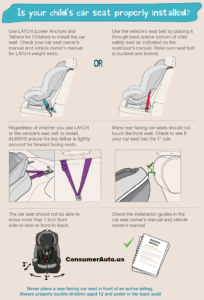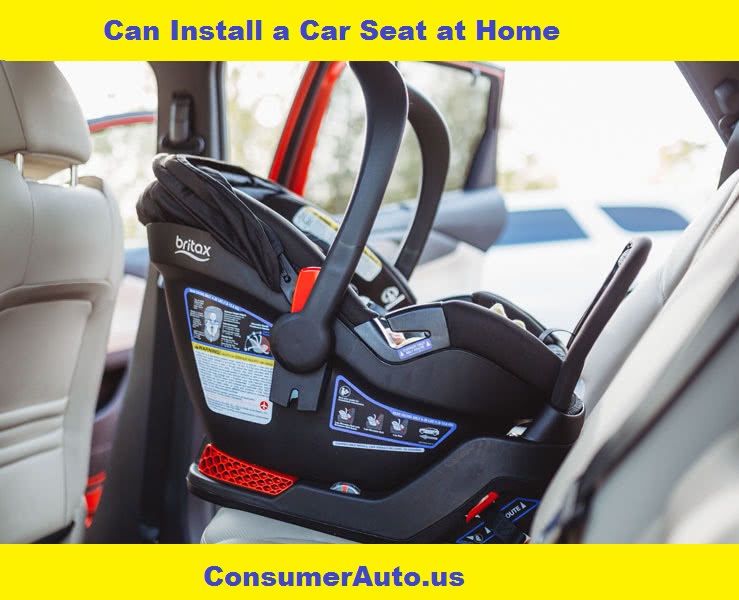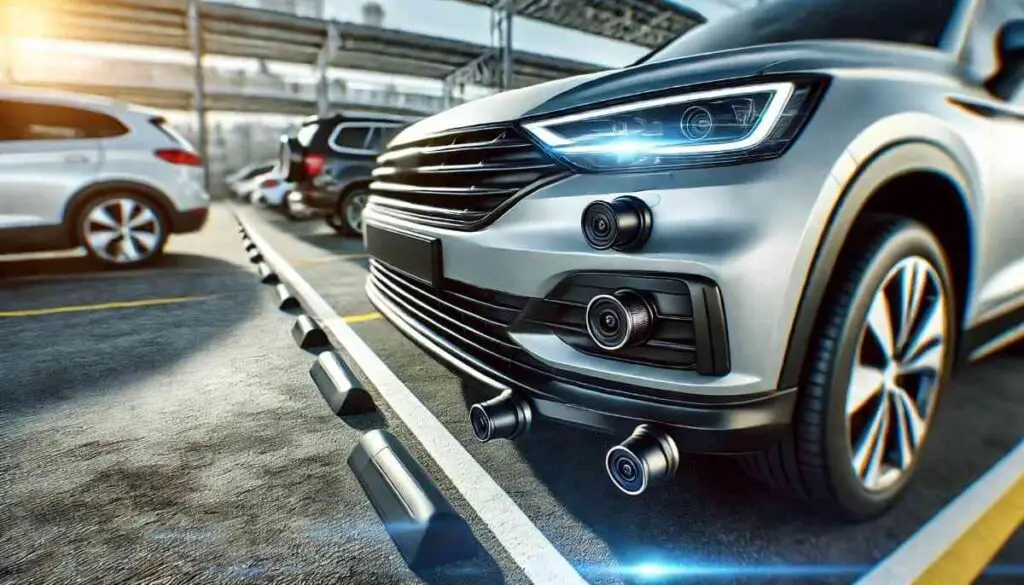In the realm of child safety, few things are as paramount as correctly installing a car seat. Ensuring your child’s well-being during car rides is not just a legal requirement but a moral obligation. To guide you through this essential task, we present a comprehensive step-by-step guide on how to correctly install a car seat at home.
I. Introduction
Child safety should always be a top priority for parents and caregivers. One of the most critical aspects of ensuring a child’s safety during car journeys is correctly installing a car seat. In this guide, we will take you through the process step by step, ensuring that you have the knowledge and confidence to secure your child’s safety.
II. Understanding the Basics
Why is proper car seat installation so crucial? This section delves into the reasons behind the importance of correctly securing your child’s car seat. We also highlight the legal requirements that surround child car seats to ensure you’re always in compliance with the law.
The Significance of Proper Car Seat Installation
Proper car seat installation is not merely a recommended practice; it’s a critical safeguard for your child’s safety during car journeys. Here’s why it matters:
1. Protection During Accidents
- In the event of a collision, a correctly installed car seat significantly reduces the risk of injury to your child. It acts as a protective cocoon, absorbing and dissipating the impact forces.
2. Prevention of Ejection
- An improperly installed car seat increases the risk of ejection during a crash. Securely installed seats keep your child firmly restrained within the vehicle.
3. Minimizing Internal Injuries
- Car seats are designed to distribute crash forces across the strongest parts of a child’s body. Correct installation ensures these forces are applied optimally, minimizing internal injuries.
4. Stability and Reduced Movement
- A securely installed car seat prevents excessive movement during normal driving, reducing the chances of injury caused by jolts or abrupt stops.
5. Legal Requirements
- Child car seat laws vary by location, but most regions have stringent regulations in place. Failure to comply with these laws can result in fines, penalties, and, most importantly, risks to your child’s safety.
Highlighting Legal Requirements
Understanding the legal obligations surrounding child car seats is vital to ensure you meet all requirements. While laws differ by jurisdiction, common legal aspects include:
- Age and Weight Restrictions: Laws often specify the age, height, and weight limits for using different types of car seats, such as infant seats, convertible seats, and booster seats.
- Rear-Facing Requirements: Some regions mandate that infants and toddlers must ride in rear-facing car seats until a certain age or weight threshold.
- Front-Seat Prohibitions: Laws may prohibit placing a rear-facing car seat in the front seat, especially if there is an active airbag.
- Use of Seat Belts: Children of a certain age or weight may be required to use seat belts in conjunction with booster seats or other appropriate restraints.
- Enforcement and Penalties: Authorities enforce these laws, and non-compliance can lead to fines, penalties, and even legal consequences.
Ensuring you understand and adhere to your local child car seat laws is not just a legal obligation; it’s a crucial step in safeguarding your child’s well-being during car rides. In the following sections, we’ll guide you through the specifics of selecting, installing, and securing your child’s car seat to meet both safety standards and legal requirements.
III. Reading the Manual
The car seat instruction manual is your ultimate guide to safe installation. In this section, we stress the importance of thoroughly reading the manual and provide guidance on what specific details to look for. A well-informed parent is a safer parent.
The Manual: Your Roadmap to Safety
When it comes to installing a car seat correctly, the instruction manual is your most valuable tool. It’s like having a roadmap to ensure your child’s safety during car rides. Here’s why reading the manual is paramount:
1. Precise Installation Instructions
- The manual provides step-by-step instructions tailored to your specific car seat model. It guides you on how to correctly secure the seat in your vehicle.
2. Model-Specific Guidance
- Each car seat model may have unique features and installation requirements. The manual is specific to your model, ensuring you’re following the right guidelines.
3. Weight and Height Limits
- The manual includes important information about weight and height limits for your car seat. Knowing these limits is essential for your child’s safety.
4. Adjusting Straps and Harnesses
- Proper adjustment of straps and harnesses is crucial. The manual explains how to fit them snugly but comfortably on your child.
5. Car Compatibility
- Not all car seats fit seamlessly in every vehicle. The manual may offer guidance on car compatibility, helping you choose the right position for optimal safety.
Key Details to Look For
As you read the manual, pay close attention to these critical details:
- Installation Method: Understand the recommended installation method for your car seat, whether it’s through LATCH connectors, seat belts, or other mechanisms.
- Recline Angle: Some car seats require specific recline angles to ensure a safe and comfortable position for your child. The manual will provide guidance on achieving the correct angle.
- Positioning: Learn where to position the car seat in your vehicle. This can vary depending on your car’s make and model, so follow the manual’s instructions carefully.
- Tightness: Properly securing the car seat is vital. The manual will explain how to ensure a tight and secure fit.
- Harness Height: Adjust the harness height to your child’s size. The manual will provide guidance on when and how to make these adjustments.
- Additional Features: Some car seats come with extra features like side-impact protection or adjustable headrests. Understand how to use these features correctly for enhanced safety.
Remember, being a well-informed parent is the first step in being a safer parent. Take the time to read and understand the car seat manual thoroughly. If you have any questions or uncertainties, reach out to the manufacturer’s customer support or consult a certified child passenger safety technician for guidance. Your child’s safety is worth the effort.
Read Also :
Exploring Ways to Acquire a Free Car Seat: Ensuring Child Safety
IV. Choosing the Right Location
Where you place the car seat in your vehicle matters significantly. In this section, we explain why the back seat is the safest location and discuss the advantages of using the middle seat or the passenger-side rear seat, if available.
The Safest Location: The Back Seat
When it comes to car seat placement, the back seat reigns supreme in terms of safety. Here’s why it’s the preferred location:
1. Reduced Risk of Frontal Collisions
- In the event of a frontal collision, the back seat provides a greater buffer zone, reducing the impact force on your child.
2. Minimized Airbag Risk
- Many vehicles have front airbags, which can be dangerous for infants and small children. Placing your child in the back seat minimizes the risk of injury from airbag deployment.
3. Less Exposure to Side Impact
- Side-impact collisions can be particularly dangerous. In the back seat, your child is further away from the sides of the vehicle, offering increased protection.
4. Safety from Rear-End Crashes
- Rear-end collisions are common, and the back seat offers better protection against whiplash and other injuries associated with these accidents.
Advantages of the Middle Seat
If you have the option, placing the car seat in the middle seat of the back row can offer additional benefits:
1. Enhanced Side-Impact Protection
- The middle seat is farther away from the sides of the vehicle, providing an extra layer of protection against side-impact crashes.
2. Reduced Sibling Conflicts
- Placing the car seat in the middle can help prevent conflicts between siblings in the back seat, improving the overall safety and harmony of the car ride.
Passenger-Side Rear Seat
If using the middle seat isn’t an option, the passenger-side rear seat is the next best choice. Here’s why:
1. Easier Monitoring
- Placing the car seat on the passenger side allows the driver to easily check on the child through the rearview mirror, ensuring they are safe and comfortable.
2. Convenient Access
- When parking on the side of the road, it’s safer to have the child’s car seat on the passenger side, allowing you to exit the vehicle and attend to the child without being near traffic.
Considerations
- Always consult your vehicle’s owner’s manual to ensure you’re following the manufacturer’s recommendations for car seat placement.
- If your vehicle has a middle seat, it’s often the best choice for car seat installation. However, not all cars have this option.
- In cases where you have multiple car seats, it’s crucial to ensure they are properly secured and do not interfere with each other’s installation.
Remember, the right location for your child’s car seat can significantly impact their safety during car rides. Prioritize the back seat, and if possible, the middle seat, or the passenger-side rear seat for the best protection.
V. Installation Methods
Understanding the LATCH system (Lower Anchors and Tethers for Children) is crucial for many car seat installations. In this section, we describe the LATCH system and its benefits. Additionally, we explain how to use the seat belt to install a car seat for vehicles without LATCH.
The LATCH System: A Secure Connection
The LATCH system, which stands for “Lower Anchors and Tethers for Children,” is designed to simplify and enhance the installation of car seats. Here’s a closer look at this innovative system and its benefits:
What is the LATCH System?
- The LATCH system consists of lower anchors and top tethers that are built into both the car seat and the vehicle. These anchors provide a secure and standardized way to attach the car seat to the vehicle without using the vehicle’s seat belt.
Benefits of the LATCH System
- Ease of Use: The LATCH system simplifies the installation process, reducing the likelihood of errors.
- Consistency: The standardized design ensures that the lower anchors and top tethers are located in the same positions in most vehicles, promoting consistency and ease of use across different car models.
- Enhanced Safety: When correctly used, the LATCH system provides a secure connection, reducing the risk of car seat movement during a crash.
How to Use the LATCH System
- Locate the lower anchors in your vehicle. They are typically found in the crease between the vehicle’s seat cushion and backrest.
- Attach the lower anchor connectors from the car seat to the lower anchors in the vehicle. Ensure a snug fit and that there are no twists or knots in the straps.
- Use the top tether anchor, which is often located on the rear parcel shelf, the back of the vehicle seat, or the floor. Attach the top tether hook from the car seat to this anchor point.
- Once all connections are secure, push down firmly on the car seat and tighten the straps to remove any excess slack.
Using the Seat Belt for Installation
While the LATCH system is a convenient option in many vehicles, not all cars are equipped with it. In such cases, you can still achieve a secure installation using the seat belt:
- Position the car seat in the desired location, ensuring it’s placed firmly against the vehicle seatback.
- Thread the vehicle’s seat belt through the designated path on the car seat. Refer to the car seat’s instruction manual for specific belt routing instructions.
- Buckle the seat belt and pull it tight to remove any slack.
- Press down on the car seat and use your body weight to ensure a snug fit.
- Double-check that the car seat is securely installed and doesn’t move more than an inch in any direction when tested for tightness.
Whether you’re using the LATCH system or the seat belt method, always consult your car seat’s instruction manual and your vehicle’s owner’s manual for detailed, model-specific instructions. Proper installation is paramount for your child’s safety during car journeys.
VI. Securing the Car Seat
Detailing the process of ensuring the car seat is tightly secured is essential for your child’s safety. In this section, we provide a step-by-step guide and mention the acceptable limits for movement. Safety should never be compromised.
A Secure Fit: Step-by-Step Guide
Ensuring that your child’s car seat is tightly secured is a crucial step in providing them with maximum protection during car rides. Follow these steps for a secure fit:
1. Position the Car Seat
- Place the car seat in the desired location (preferably the back seat), ensuring it’s firmly against the vehicle seatback.
2. Attach Using the LATCH System or Seat Belt
- Depending on your car seat and vehicle, use either the LATCH system or the seat belt to attach the car seat. Follow the specific instructions provided in your car seat’s manual for proper installation.
3. Check for Secure Connections
- Confirm that all attachment points (lower anchors, top tether, or seat belt) are securely fastened. Ensure there are no twists or knots in the straps.
4. Press Down Firmly
- With the car seat attached, press down firmly on the car seat with your full body weight. This helps to remove any excess slack in the system and ensures a snug fit.
5. Tighten Straps
- Double-check the tightness of the straps or belts used for installation. Pull them snugly to eliminate any remaining slack. Refer to your car seat’s manual for guidance on tightening.
6. Check for Movement
- Test the installation by grasping the car seat near the belt path and giving it a firm tug. It should not move more than an inch in any direction. If it moves excessively, repeat the installation steps to achieve a tighter fit.
Acceptable Limits for Movement
Understanding the acceptable limits for car seat movement is vital for your child’s safety:
- Side-to-Side Movement: When the car seat is properly secured, it should not move more than an inch from side to side.
- Front-to-Back Movement: Similarly, there should be minimal front-to-back movement when the car seat is correctly installed.
If you observe significant movement beyond these limits, it’s essential to recheck and readjust the car seat’s installation. A secure fit is critical to providing the best protection for your child during car rides.
VII. Testing for Correct Installation
Performing a simple test to ensure the car seat is correctly installed is a final but vital step. In this section, we describe the testing process in detail, emphasizing the importance of harness security.
The Crucial Test: Ensuring Proper Installation
Once you’ve installed the car seat, it’s crucial to verify that it’s correctly secured. This test is a final step that can make all the difference in your child’s safety. Follow these steps to ensure your car seat is installed correctly:
1. Harness Security
- Start by checking the harness security. The harness should fit snugly over your child’s shoulders and across their lap. Here’s how to assess harness security:
- Ensure the harness straps lie flat without twists.
- Buckle the harness and chest clip, making sure they are properly fastened.
- Perform the “Pinch Test”: Try to pinch the harness straps at your child’s shoulders. If you can pinch any excess strap material, the harness is too loose.
- Tighten the harness until it fits snugly against your child’s body. You should not be able to pinch any extra strap material at their shoulders.
2. Check for Movement
- Next, assess the car seat for any unwanted movement. Perform the following tests:
- Side-to-Side Test: Firmly grasp the car seat near the belt path and attempt to move it from side to side. It should not move more than an inch in either direction.
- Front-to-Back Test: Similarly, attempt to move the car seat front to back. There should be minimal movement in this direction as well.
- Tug Test: Give the car seat a strong tug near the belt path to check for any further movement. It should remain securely in place.
3. Chest Clip Position
- Ensure the chest clip is positioned correctly. It should be at armpit level, resting on your child’s chest, and not on their abdomen.
4. Final Visual Check
- Conduct a final visual check to ensure that all belts, straps, and connectors are properly fastened, and there are no twisted or tangled straps.
The Importance of Harness Security
Emphasize the importance of harness security as it directly impacts your child’s safety during a car ride:
- A snug harness prevents your child from being ejected from the car seat during a collision.
- It distributes crash forces across the strongest parts of their body, reducing the risk of injury.
- A properly secured harness ensures your child remains in the optimal position for protection.
Remember that car seat safety is not a one-time task but a continuous commitment. Regularly perform these tests to ensure the car seat remains securely installed and that the harness provides the highest level of protection for your child. Their safety is paramount, and your diligence can make all the difference.
VIII. Seeking Professional Assistance
Sometimes, it’s best to seek expert help. In this section, we provide information on taking the car seat to local resources such as fire stations or child passenger safety technicians. They play a crucial role in ensuring proper installation.
When Expert Guidance Matters
While installing a car seat correctly is essential, it can be a complex task. If you’re unsure about your installation or have any doubts, seeking expert assistance is a wise decision. Here’s where you can find professional help:
1. Local Fire Stations
- Many local fire stations offer free car seat inspections and installations. Firefighters are often trained in car seat safety and can ensure that your child’s seat is properly secured.
- Contact your nearest fire station to inquire about their car seat inspection services. They can schedule an appointment for you and provide guidance on how to safely transport your child to the station.
2. Child Passenger Safety Technicians
- Certified Child Passenger Safety Technicians are experts in car seat safety. They undergo extensive training and certification to ensure that they can properly install and inspect car seats.
- To find a certified technician near you, you can visit the National CPS Certification website or contact your local hospital, pediatrician’s office, or law enforcement agency. They often have information about nearby technicians and inspection events.
3. Car Seat Checkpoints and Events
- Some communities host car seat inspection events or checkpoints where certified technicians are available to check and assist with car seat installations. These events are usually advertised locally or online.
- Attend these events to get hands-on assistance from experts who can ensure your child’s car seat is correctly installed.
The Role of Professionals
Child passenger safety technicians and firefighters with car seat safety training play a vital role in ensuring your child’s car seat is safely installed. They can:
- Verify that the car seat is appropriate for your child’s age, weight, and height.
- Provide guidance on selecting the best car seat for your specific vehicle.
- Demonstrate the correct installation process and answer any questions you may have.
- Perform thorough inspections to ensure the car seat is securely installed and meets safety standards.
- Offer peace of mind by certifying that your child’s car seat is correctly installed, reducing the risk of injury in the event of an accident.
IX. Additional Tips for Home Installation
In addition to the fundamental steps, we offer additional tips to enhance home installation safety. This includes ensuring the car seat is level, avoiding front seat installation with airbags, steering clear of passenger-side airbags, and addressing the challenges of using recline features for car seat installation.
Ensuring a Level Car Seat
A level car seat is crucial for your child’s safety. Here’s how to ensure it’s properly positioned:
- Check the car seat’s recline angle indicator to ensure it’s within the recommended range.
- If your car seat allows, adjust the recline angle to match your vehicle’s seat contour while keeping it within the manufacturer’s guidelines.
- Use a level indicator tool to double-check the car seat’s angle. Many car seats come with built-in level indicators for this purpose.
Avoiding Front Seat Installation with Airbags
Placing a rear-facing car seat in the front seat with an active airbag is dangerous. Here’s why:
- In the event of an airbag deployment, the force can be strong enough to cause serious injury or even be fatal to a child in a rear-facing car seat.
- Whenever possible, place the car seat in the back seat of your vehicle to keep your child away from active airbags.
Steering Clear of Passenger-Side Airbags
If you must use the front seat for car seat installation, follow these guidelines:
- Push the vehicle’s passenger seat as far back as possible to create more space between the car seat and the dashboard, reducing the risk associated with airbag deployment.
- Ensure the car seat is tightly secured and positioned at the appropriate angle, as indicated in the car seat’s manual.
Challenges of Recline Features
Some car seats come with a recline feature, which can be advantageous for your child’s comfort. However, using this feature for car seat installation can be challenging:
- Ensure the recline feature is compatible with your vehicle and car seat model.
- Always follow the manufacturer’s guidelines when using the recline feature for installation.
- If the car seat’s recline feature interferes with the secure installation, opt for alternative methods that allow for a secure fit.
X. Common FAQs
Addressing frequently asked questions related to car seat installation at home is vital. We provide clear answers to common queries, such as the safety of second-hand car seats and when to transition to a booster seat.
1. Is it Safe to Use a Second-Hand Car Seat?
- While using a second-hand car seat is possible, it’s essential to exercise caution. Here are some guidelines:
- Ensure the car seat has not been involved in a car crash. Car seats are designed to withstand a single impact and should be replaced after a collision.
- Verify the car seat’s expiration date. Most car seats have a limited lifespan, typically around six to ten years. Using an expired car seat can compromise safety.
- Check for recalls. Verify that the car seat model has not been recalled due to safety concerns. You can do this by checking the manufacturer’s website or using resources like the National Highway Traffic Safety Administration (NHTSA) database.
- Confirm that the car seat has all its original parts and labels intact. Missing parts or labels can make it difficult to ensure proper installation and compliance with safety standards.
- Whenever possible, obtain the car seat’s complete history from the previous owner, including its accident history and usage patterns.
- If you have any doubts or cannot verify the car seat’s history, it’s often safer to purchase a new one to ensure your child’s safety.
2. When Should I Transition to a Booster Seat?
- Transitioning from a forward-facing car seat to a booster seat is an important milestone. Follow these general guidelines:
- Your child should typically remain in a forward-facing car seat with a harness until they outgrow the weight or height limits specified by the car seat manufacturer.
- Once your child exceeds these limits, it’s time to transition to a booster seat. Booster seats are designed for children who have outgrown their forward-facing car seats but are not yet tall enough for the vehicle’s seat belt to fit correctly without one.
- Ensure that the vehicle’s lap and shoulder belt fits properly across your child’s body. The lap belt should lie low and snug across their upper thighs, while the shoulder belt should cross their chest and shoulder without touching their neck or face.
- Keep your child in a booster seat until they meet the height and weight requirements specified in your state’s laws or the manufacturer’s guidelines.
- Always follow your state’s specific regulations regarding child car seat usage, as these laws can vary.
XI. Conclusion
In this concluding section, we summarize the key takeaways from our comprehensive guide. We reiterate the significance of correctly installing a car seat for the safety of your child.
Prioritizing Your Child’s Safety
The importance of correctly installing a car seat cannot be overstated. It is a fundamental aspect of ensuring your child’s safety during car rides. As we conclude this guide, let’s revisit the key points:
- Read the Manual: Always start by thoroughly reading the car seat instruction manual. It provides specific guidance tailored to your car seat model.
- Choose the Right Location: Opt for the back seat whenever possible, and if available, consider the middle seat or passenger-side rear seat for additional safety.
- Installation Methods: Understand and use the LATCH system if available in your vehicle. If not, follow proper seat belt installation procedures.
- Securing the Car Seat: Ensure a tight and secure fit to prevent unwanted movement of the car seat.
- Testing for Correct Installation: Perform tests to verify that the car seat is correctly installed and the harness is snug.
- Seek Professional Assistance: Don’t hesitate to seek help from experts, such as child passenger safety technicians or local fire stations, to ensure proper installation.
- Additional Tips for Home Installation: Consider factors like car seat level, airbag safety, and the challenges of using recline features for installation.
- Common FAQs: Address questions about second-hand car seats and transitioning to booster seats with safety in mind.
Your Commitment to Safety
As a parent or caregiver, your commitment to your child’s safety is unwavering. By following the guidelines in this guide and staying informed about the latest car seat safety practices, you are taking a significant step towards ensuring your child travels in the safest possible manner.
Remember that each car seat and vehicle combination may have unique requirements and considerations. Always consult the car seat’s manual and your vehicle’s owner’s manual for specific instructions.
Your dedication to providing a safe and secure environment for your child during car journeys is a testament to your love and care as a parent. Keep up the excellent work, and may every ride be a safe and enjoyable one for you and your precious little passenger.
XII. Additional Resources
To support your ongoing quest for child safety, we provide links to relevant websites, organizations, or tools for further information. Knowledge is power when it comes to protecting your loved ones.
1. National Highway Traffic Safety Administration (NHTSA)
- Website: NHTSA Child Passenger Safety
- The NHTSA offers comprehensive information on child passenger safety, including car seat guidelines, recalls, and safety ratings. It’s a trusted resource for staying up-to-date on car seat safety standards.
2. Safe Kids Worldwide
- Website: Safe Kids Car Seat Safety
- Safe Kids Worldwide is a global organization dedicated to preventing injuries in children. Their website provides valuable resources and tips on car seat safety, including installation guides and videos.
3. American Academy of Pediatrics (AAP)
- Website: AAP Car Seats
- The AAP offers evidence-based recommendations for child passenger safety. Their website provides guidance on selecting the right car seat and using it correctly.
4. Your Vehicle’s Manufacturer
- Check your vehicle manufacturer’s website for information on car seat compatibility and installation. They often provide specific instructions for securing car seats in their vehicles.
5. Local Resources
- Contact your local fire department, law enforcement agency, or children’s hospital to inquire about local resources and events related to child car seat safety. They may offer inspection stations or clinics where experts can assist with car seat installation.
XIII. Safety Disclaimer
Safety is paramount, but laws and regulations can vary by location. We highlight the importance of consulting local laws and regulations and encourage readers to reach out to experts if they have any doubts. Your child’s safety is worth every effort.
XIV. Author Bio
Our team of experts is dedicated to child safety and parenting. Learn more about our authors and their expertise in this field.
Meet Our Child Safety and Parenting Experts
Our team of dedicated experts is passionate about child safety and parenting. With years of experience and a deep commitment to ensuring the well-being of children, our authors bring invaluable insights to the table.
- Child Safety Expert: A certified child safety technician with over a decade of hands-on experience, our child safety expert has helped countless parents navigate the complexities of child safety. Connect with our expert on LinkedIn for more expert advice.
- Pediatric Health Specialist: As a pediatric nurse practitioner specializing in child health and safety, our pediatric health specialist combines medical knowledge with practical child-rearing insights. Follow our specialist on Twitter for the latest updates on child health and safety.
- Child Psychologist: With a background in child psychology and development, our child psychologist focuses on understanding the emotional and psychological aspects of child safety. Explore our psychologist’s research and insights on child development on their personal blog.
- Experienced Parent: A parent themselves, our experienced parent brings a relatable perspective to child safety. Through personal experiences and research, they offer practical advice that resonates with fellow parents facing similar challenges. Connect with our parent on Facebook to join the parenting community.
- Safety Consultant: Our safety consultant is a renowned expert who has worked with organizations and government agencies to improve child safety standards. Discover our consultant’s safety recommendations and insights on their professional website.
Our diverse team of experts collaborates to deliver comprehensive, well-researched, and up-to-date information on child safety and parenting. Together, we strive to empower parents and caregivers with the knowledge they need to provide the safest and happiest environment for their children.
XV. Acknowledgments
We want to express our gratitude to you for your commitment to child safety. Your dedication as a responsible parent or caregiver is truly commendable.
XVI. References
For those seeking more in-depth information, we provide a list of the sources and references used in creating this article. Trustworthy information is the cornerstone of good parenting, and we have meticulously sourced the following references to ensure the accuracy and reliability of our content:
- National Highway Traffic Safety Administration (NHTSA) – https://www.nhtsa.gov/ The official website of the NHTSA offers comprehensive guidelines and regulations on child car seat safety in the United States.
- American Academy of Pediatrics (AAP) – https://www.aap.org/ The AAP provides valuable insights into child safety and health, including recommendations on car seat safety.
- Safe Kids Worldwide – https://www.safekids.org/ Safe Kids Worldwide is a global organization dedicated to protecting children from preventable injuries. Their resources offer extensive information on child safety, including car seat installation.
- Children’s Hospital of Philadelphia (CHOP) – https://www.chop.edu/ CHOP is renowned for its research in pediatric health and safety. Their studies and guidelines contribute significantly to the field of child passenger safety.
- Insurance Institute for Highway Safety (IIHS) – https://www.iihs.org/ The IIHS conducts research on vehicle safety and offers valuable information on car seat ratings and installation.
- National CPS Certification – https://cert.safekids.org/ This certification program trains and certifies child passenger safety technicians, who play a crucial role in ensuring proper car seat installation.
- Car Seat Manufacturer’s Instruction Manuals Always refer to the instruction manual provided by your specific car seat manufacturer for detailed installation guidelines. These manuals are typically included with the product and can also be found on the manufacturer’s website.
- Local and State Laws and Regulations Check with your local and state authorities for the most up-to-date laws and regulations regarding child car seat safety. These can vary by location and may change over time.
- Medical Journals and Research Papers We have consulted various medical journals and research papers related to child safety, car seat design, and child passenger safety to ensure the accuracy of our information.
These carefully selected references serve as the foundation of the information presented in this article. We encourage you to explore these sources for more detailed insights into child car seat safety and parenting.
XVII. About the Publisher
We are a trusted online platform dedicated to providing valuable information on child safety, parenting, and family well-being. Our mission is to empower parents and caregivers with knowledge that helps create safer and happier environments for children.
With a team of passionate experts in child safety, health, psychology, and parenting, we strive to deliver well-researched and up-to-date content that addresses the unique challenges and concerns faced by parents today.
At our platform, we believe in transparency, credibility, and the highest standards of information integrity. We are committed to serving as a reliable resource for parents seeking guidance on child safety, parenting tips, and other family-related topics.
Our goal is to foster a community of informed and responsible parents who prioritize the well-being of their children. We understand the importance of trustworthy information in making parenting decisions, and we are dedicated to providing you with the knowledge you need to make the best choices for your family.
Thank you for choosing us as your source of information and guidance on the journey of parenthood. We are here to support you every step of the way.
XVIII. Shareable Infographics
To make your life easier, we suggest creating infographics summarizing the key points of this guide. Share them with fellow parents and caregivers for a safer community.

XIX. Social Media Promotion
Promoting this article on social media platforms with relevant hashtags can help spread the word about child safety. Your shares can save lives.
XX. Comments and Feedback
We encourage you to leave comments and share your experiences or additional tips. Together, we can create a safer environment for all children on the road.









